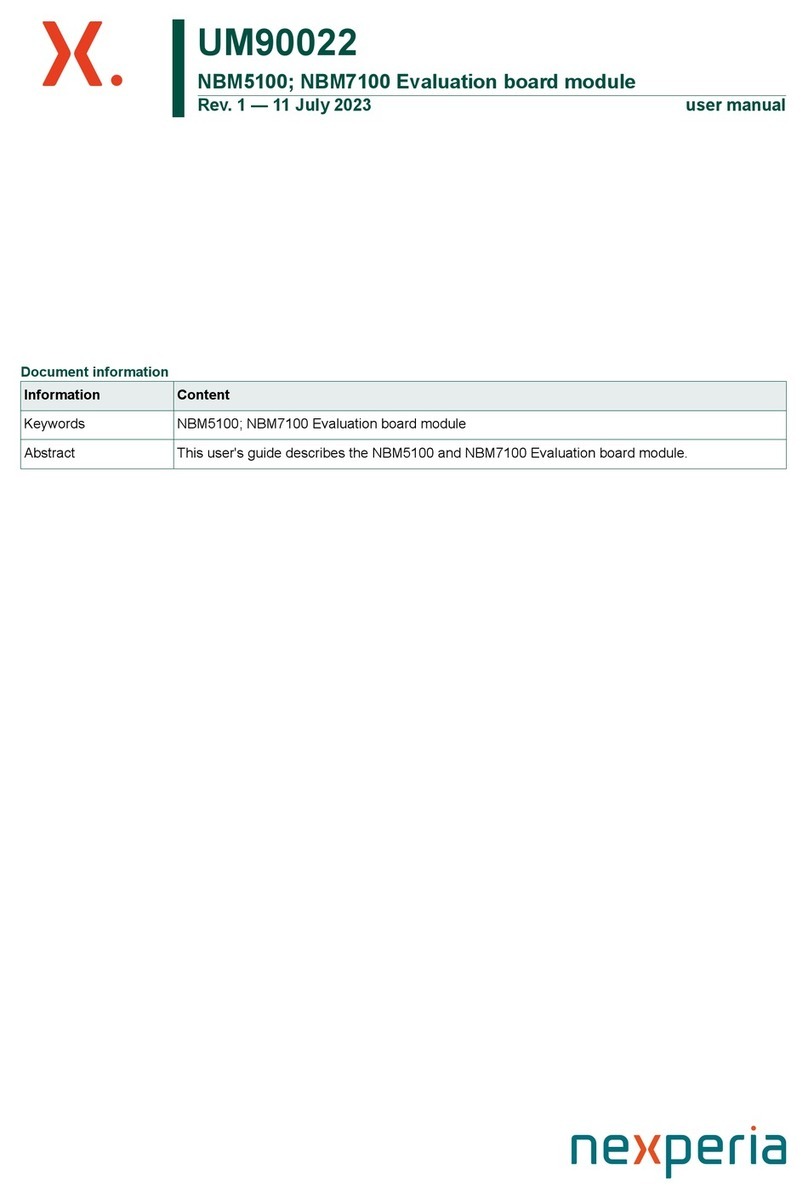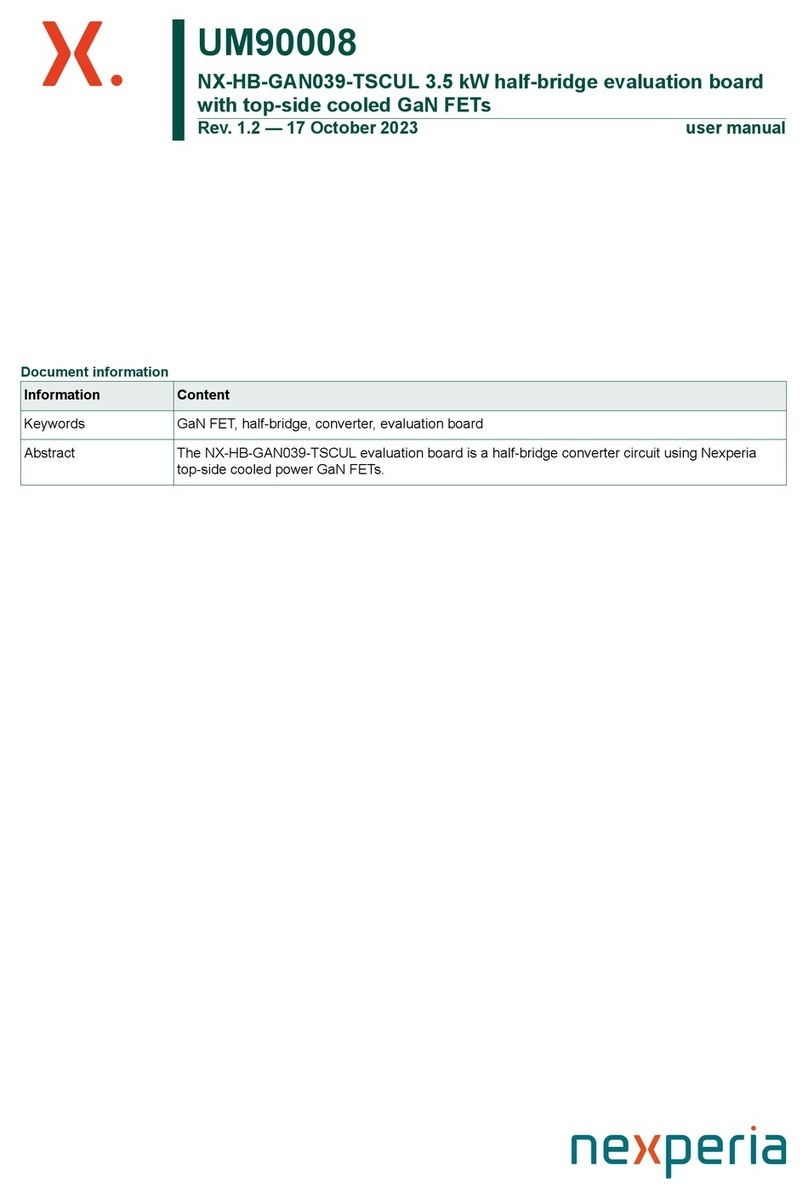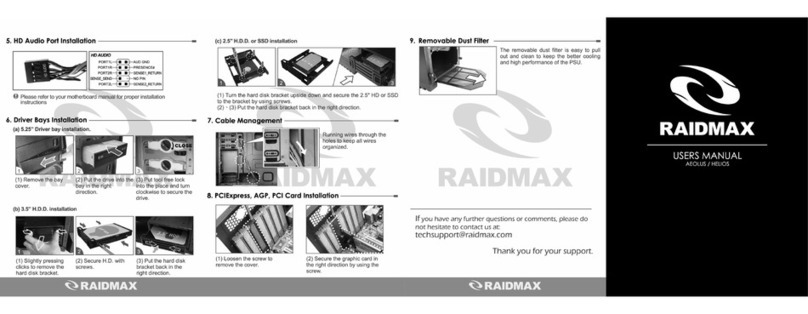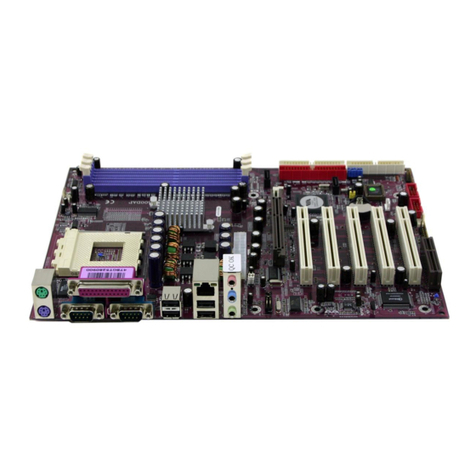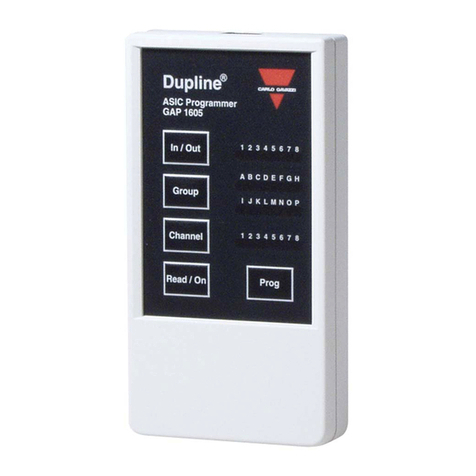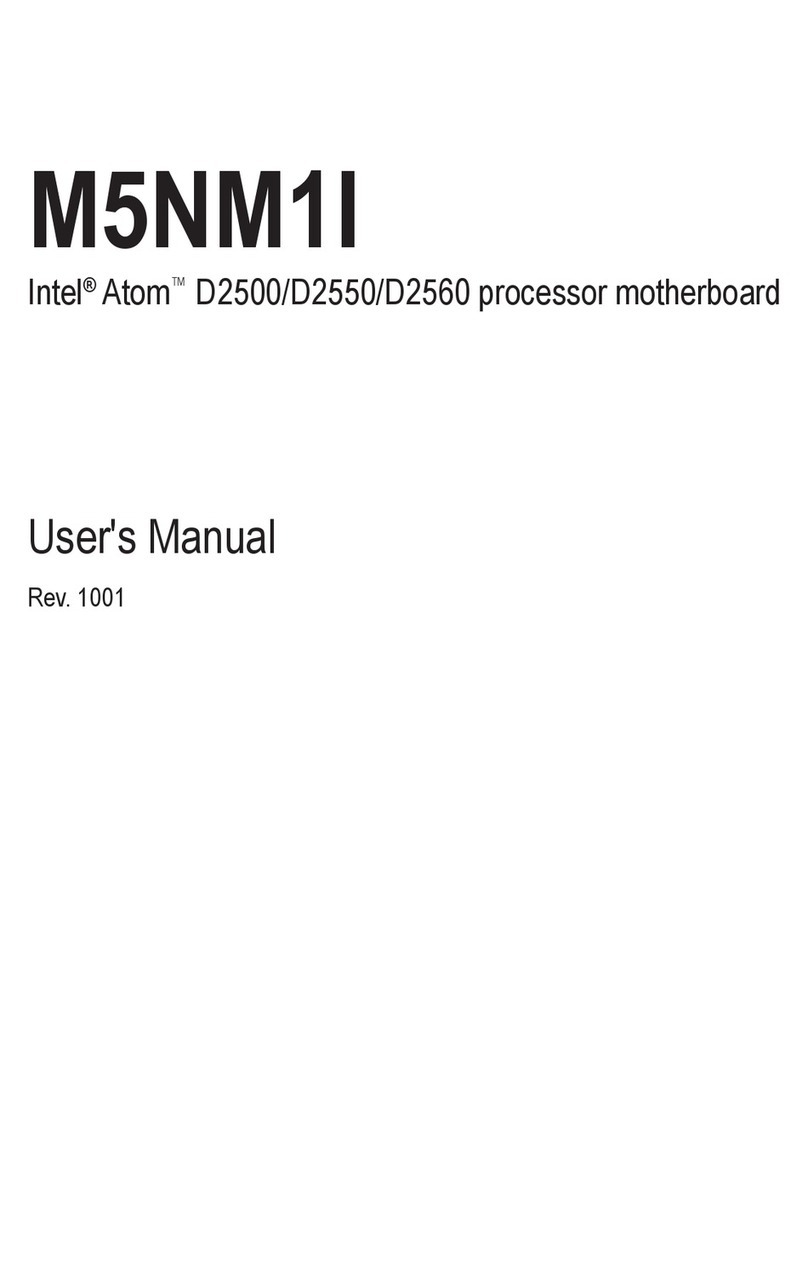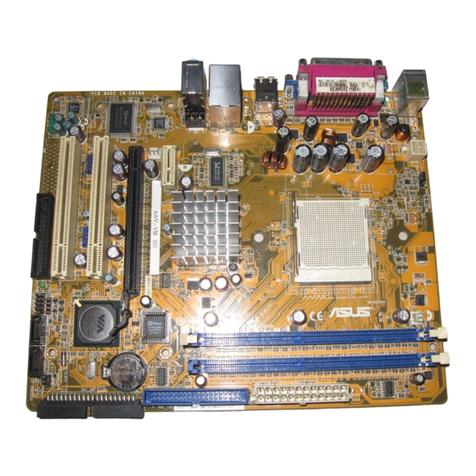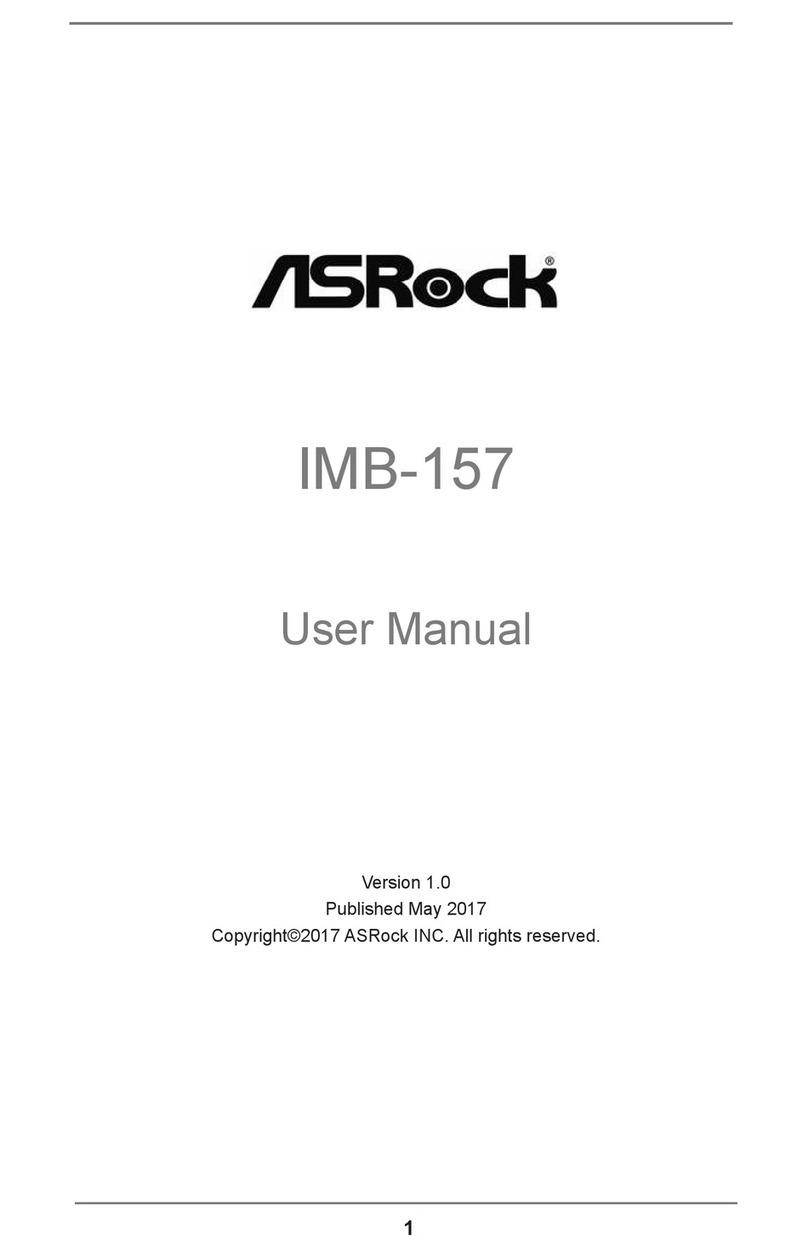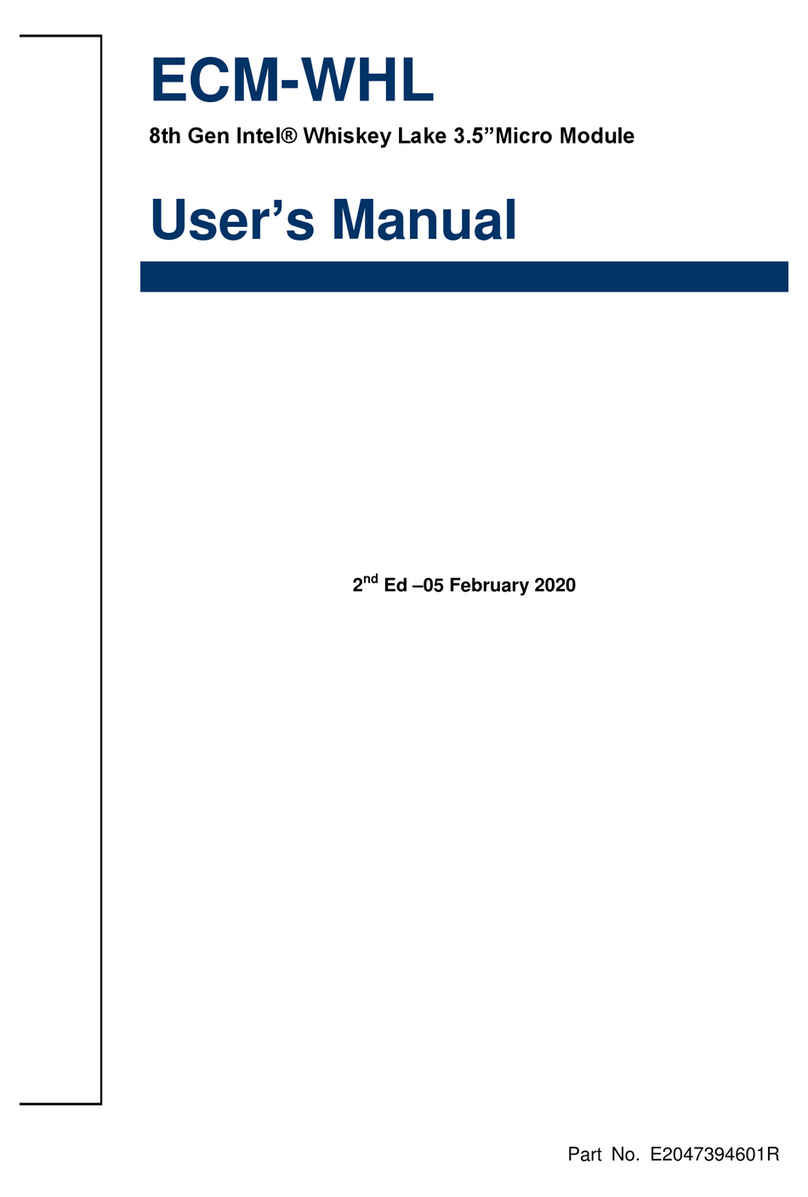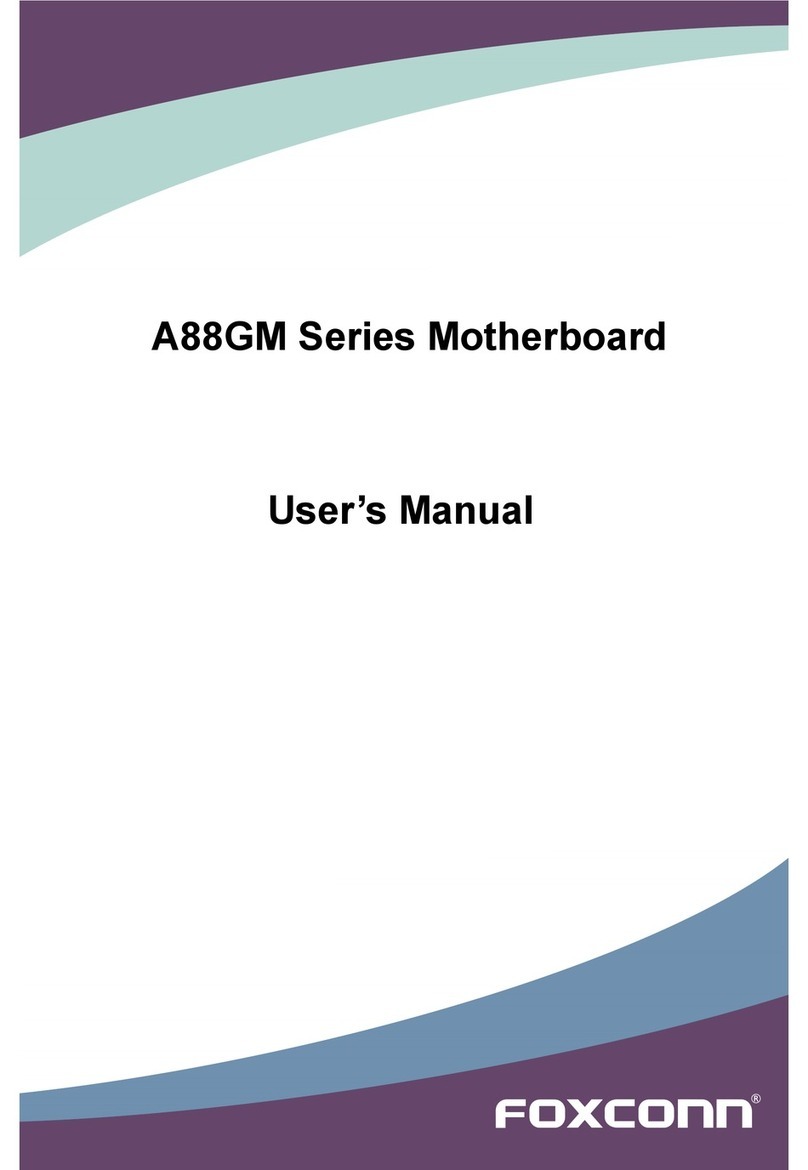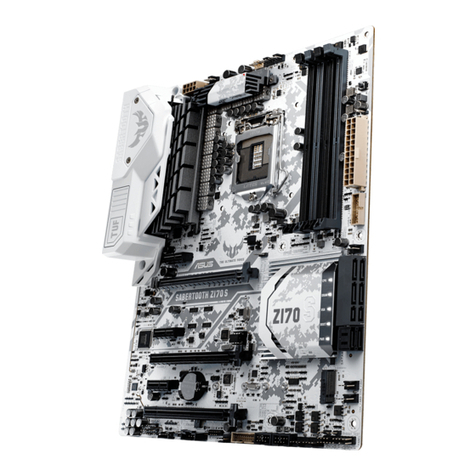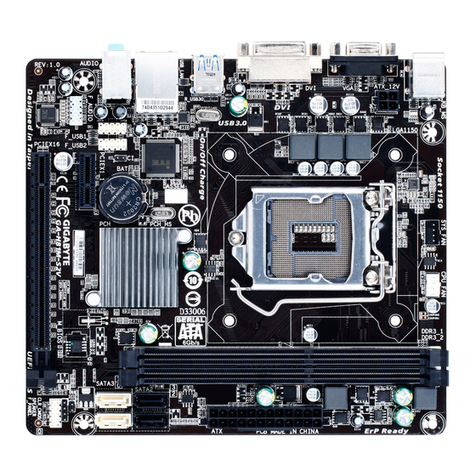Nexperia NCA95 Series User manual

UM90016
NCA95xx GPIO expander EVB (Arduino™ shield compatible)
Rev. 1.0 — 4 January 2023 user manual
Document information
Information Content
Keywords General Purpose Input/Output (GPIO) Expander, Evaluation Board (EVB), Arduino™ shield
Abstract The NCA95xx EVB (Evaluation Board) is an Arduino™ compatible shield form factor PCB
designed for the Nexperia I²C controlled GPIO expander family. The board provides convenient
test points for GND, I²C-Bus signals SCL and SDA as well as an interrupt open drain output.
The EVB can be used for the GPIO expander derivatives NCA9555, NCA9535, NCA9539 and
NCA9595.

Nexperia UM90016
NCA95xx GPIO expander EVB (Arduino™ shield compatible)
1. Introduction
The NCA95xx EVB (Evaluation Board) is a PCB designed for the Nexperia I²C controlled GPIO
expander family. The EVB arrives enclosed in an antistatic ESD bag with labeling. The board
provides convenient test points for GND, I²C-Bus signals SCL and SDA as well as an interrupt
open drain output. The EVB can be used for the GPIO expander derivatives NCA9555, NCA9535,
NCA9539 and NCA9595.
The EVB is designed in an Arduino™ compatible shield form factor that allows easy development
with Nexperia’s line of available I²C GPIO I/O expanders. There is also supplementary firmware
for the Arduino™ to aid in the development of applications with the NCA95xx family of devices. An
image of the NCA95XX EVB is shown in Fig. 1
Fig. 1. NCA95xx (Arduino™ shield compatible) Evaluation Board
1.1. Features
•EVB name = NCA95xx EVB
•Device = NCA95xx
•Input voltage = 1.6 V to 5.5 V
•I²C to parallel port expansion
•Number of GPIOs = 2 ports with 8 bits
•Current drive capability = ± 25 mA
•I²C interface, Fast-Mode 400 kHz
•Open-drain active-low interrupt output
•Configurable slave address via 3 selection
pins (2 pins for NCA9539)
•Low-active reset input (NCA9539)
•Polarity inversion register (for read
operation)
UM90016 All information provided in this document is subject to legal disclaimers. © Nexperia B.V. 2023. All rights reserved
user manual Rev. 1.0 — 4 January 2023 2 / 22

Nexperia UM90016
NCA95xx GPIO expander EVB (Arduino™ shield compatible)
Further details about the specification and parameters of NCA9555, NCA9535, NCA9539 and
NCA9595 can be found in their respective data sheets, but a high-level summary is provided in
Table 1 below:
Table 1. NCA95xx family features
Device Package Feature
NCA9555PW TSSOP24
NCA9555BY HWQFN24
•integrated 100 kΩ pull-up resistors for GPIO pins
NCA9535PW •no integrated termination of GPIO pins
•advantage: no extra current for active outputs in low state
NCA9595PW •2 additional I²C registers for switchable pull-up resistors
NCA9539PW
TSSOP24
•additional Reset pin (low active) A2 address selection pin is
sacrificed ( 4 address options)
•no internal termination like NCA9535
2. Hardware set up
The proceeding section describes the EVB jumper and header description, installation of firmware
on the Arduino™ UNO board or compatible alternative and installation of the software (GUI) on PC.
2.1. Headers J1/J2/J3/J4 - Arduino™ Uno interface
Headers J1, J2, J3, and J4 serve as the physical interface between the Arduino board and
the EVB. The included software supports fast development and evaluation with the NCA95XX
devices. If using other microcontrollers, or wiring to an application, these headers also allow quick
prototyping by either directly connecting to a breadboard or using wires to directly connect nets to
customer applications.
A detailed description of the header pinouts are listed in the tables presented below:
Table 2. J1 headers
J1 net name Pin number Description
SCL 1 SCL I²C-Bus Signal Line
SDA 2 SDA I²C-Bus Signal Line
GND 4 GND connection
Table 3. J2 headers
J2 net name Pin number Description
3.3 V 4 3.3 V Arduino Supply Voltage
5 V 5 5V Arduino Supply Voltage
GND 6 GND connection
GND 7 GND connection
J3 header has no connections from NCA95XX device. Please reference Arduino pin table.
Table 4. J4 headers
J4 net name Pin number Description
/INT 1 /INT pin (9555)
Add1 2 Addr 1 pin
Add2 3 Addr 2 pin
Add0 4 Addr 0 pin
UM90016 All information provided in this document is subject to legal disclaimers. © Nexperia B.V. 2023. All rights reserved
user manual Rev. 1.0 — 4 January 2023 3 / 22

Nexperia UM90016
NCA95xx GPIO expander EVB (Arduino™ shield compatible)
2.2. Header J5 - selectable VCC
J5 allows a shunt to connect VCC to either 3.3 V or 5 V core voltages. As the Arduino UNO is
native to 5 V, the default option is for the shunt to connect to 5 V supply.
Table 5. J5 header - selectable VCC supply
J5 net name Pin number Description
3.3 V 1 3.3 V from Arduino
VCC 2 Device supply
5 V 3 5 V from Arduino
Note: If using 3.3 V with Arduino UNO, please verify that address connections to Arduino
microcontroller are set to inputs. If setting the Address pins low the digital pin can then be
reconfigured as output and set to LOW. All other I/Os on the NCA95XX are 5 tolerant.
2.3. JP5 and JP6 headers
These headers serve two purposes:
•Additional connection points to VCC, SCL, SDA, GND and other NCA95XX nets
•The EVB can also be evaluated with the Adafruit Trinket M0.
Table 6 and Table 7 display the header pinout with Net connections.
Table 6. JP5 header net names
JP5 net name Pin number Description
GND 2 GND connection
/INT 3 /INT pin (9555)
Add1 4 Addr1 net
Table 7. JP6 header net names
JP6 net name Pin number Description
VCC 1 VCC Supply voltage
SCL 2 SCL I²C-BUS signal line
Add2 3 Addr2 net
2.4. Headers J9/J10/J11 - NCA95XX GPIO
These headers provide direct connection to the GPIO pins of the populated NCA95XX device.
GPIO0 through GPIO7 refer to PORT0, and GPIO10 to GPIO17 refer to PORT1. In the EVB,
PORT1 I/Os are connected to a 300 Ω series resistor and LED. Configuring PORT1 as outputs
through software will allow the user to turn on/off their respective I/O LED.
These components are DNI on PORT0. However, the footprints are included in the case the user
wishes to manually populate. J11 includes a selectable interface between these footprints and a
push button. The push button can be connected to GPIO7 of PORT0.
UM90016 All information provided in this document is subject to legal disclaimers. © Nexperia B.V. 2023. All rights reserved
user manual Rev. 1.0 — 4 January 2023 4 / 22

Nexperia UM90016
NCA95xx GPIO expander EVB (Arduino™ shield compatible)
Table 8. J9 pinout
J9 net name Pin number Description
GPIO0 1 GPIO, DNI Resistor/LED
GPIO1 2 GPIO, DNI Resistor/LED
GPIO2 3 GPIO, DNI Resistor/LED
GPIO3 4 GPIO, DNI Resistor/LED
GPIO4 5 GPIO, DNI Resistor/LED
GPIO5 6 GPIO, DNI Resistor/LED
GPIO6 7 GPIO, DNI Resistor/LED
J11- pin 3 8 GPIO, DNI Resistor/LED
Table 9. J10 pinout
J10 net name Pin number Description
GPIO10 1 GPIO, Populated Resistor/LED
GPIO11 2 GPIO, Populated Resistor/LED
GPIO12 3 GPIO, Populated Resistor/LED
GPIO13 4 GPIO, Populated Resistor/LED
GPIO14 5 GPIO, Populated Resistor/LED
GPIO15 6 GPIO, Populated Resistor/LED
GPIO16 7 GPIO, Populated Resistor/LED
GPIO17 8 GPIO, Populated Resistor/LED
Table 10. J11 pinout
J11 net name Pin number Description
Push-button with
pull-up
1 Connecting shunt to 1-2 of J11 will connect push
button
GPIO07 2 GPIO, DNI resistor/LED
Resistor and LED
footprint
3 Connecting shunt to 2-3 of J11 will connect I/O to
resistor and LED footprint
UM90016 All information provided in this document is subject to legal disclaimers. © Nexperia B.V. 2023. All rights reserved
user manual Rev. 1.0 — 4 January 2023 5 / 22

Nexperia UM90016
NCA95xx GPIO expander EVB (Arduino™ shield compatible)
3. Software Setup
3.1. Installing the Arduino™ software
Download the software files from the EVM product page. The directory should resemble the
following with title “NCA95XX_GUI_Installation_Files”:
Fig. 2. GUI Installation Files
Navigate to the Arduino folder and run “Arduino-1.8.19-windows” or latest Arduino installer
executable. This will download necessary drivers. Once complete, verify properly installed by
verifying “Arduino” program in Start Menu, this is shown in Fig. 3 below.
Fig. 3. Arduino program at startup menu
After the Arduino software is installed, connect the NCA95XX EVB to the Arduino UNO board and
connect the USB cable to PC. Please verify correct VCC is set for the desired operation.
Now navigate in the folder to “NCA95XX_GUI_Installation_Files>Arduino>nca95xx_main” and
click on the “nca95XX_main” file. Once the Arduino IDE is up, select the correct board and port by
clicking into “Tools>Board” and “Tools>Port”, shown in Fig. 4. If the Arduino UNO is connected to
the PC via USB, the PORT information can be found by navigating to the “Device Manager” tool
and verifying port information under “Ports (COM&LPT)”.
UM90016 All information provided in this document is subject to legal disclaimers. © Nexperia B.V. 2023. All rights reserved
user manual Rev. 1.0 — 4 January 2023 6 / 22

Nexperia UM90016
NCA95xx GPIO expander EVB (Arduino™ shield compatible)
Fig. 4. Set Port COM Number
Fig. 5. Device Manager to Find COM port
Next navigate to “Sketch>Upload” to flash the program to the board, this is shown in Fig. 6.
Fig. 6. Uploading the Arduino sketch
If successfully programed, the bottom of the IDE will display “Done uploading”. Now exit the
Arduino IDE.
Fig. 7. Arduino sketch upload complete
UM90016 All information provided in this document is subject to legal disclaimers. © Nexperia B.V. 2023. All rights reserved
user manual Rev. 1.0 — 4 January 2023 7 / 22

Nexperia UM90016
NCA95xx GPIO expander EVB (Arduino™ shield compatible)
3.2. GUI software setup
The next step is to navigate to the “exeInstaller” folder and double-click the “NCA95XX” setup file.
The application is shown below, in Fig. 8, for reference.
Fig. 8. Setup executable for NCA95XX EVB GUI
This will invoke the Installer, which is shown in Fig. 9. Please click next and accept the license
agreements to install the NCA95XX EVM GUI.
Fig. 9. NCA95XX EVB GUI installer screen
After everything installs correctly, you should see the following at your startup menu:
Fig. 10. NCA95XXEVB GUI screen on startup
Clicking on the “NCA95XX EVM GUI” icon will invoke the GUI displayed in Fig. 13.
UM90016 All information provided in this document is subject to legal disclaimers. © Nexperia B.V. 2023. All rights reserved
user manual Rev. 1.0 — 4 January 2023 8 / 22

Nexperia UM90016
NCA95xx GPIO expander EVB (Arduino™ shield compatible)
Fig. 11. NCA95XX GUI program
At startup, the GUI will automatically search for the correct COM PORT that the NCA95XX EVB
and Arduino is connected to – this will take a few seconds. Once connected successfully, the
“Hardware Connected” LED will turn on, indicating that the boards are found. Another LED, “Task
Status” will activate, this LED means that a task is being completed, and will deactivate once the
task is complete. This indicator is similar to the Windows “hourglass” state.
Fig. 12. Hardware Connected and Task Status
After the GUI finds the hardware, and initial routine is executed to find the current state of the
NCA95XX device, the controls and indicators will automatically update and the “Task Status” light
will turn off. After this initial task is performed, the user can now interact with the GUI through
writes/reads or button presses. Additionally, when pressing buttons the “task status” light will turn
on when an operation/task is performed, please wait for this light to turn off before proceeding with
other button presses.
The GUI is split into two different levels of Interaction, shown in Fig. 13. The first Interactive region,
shown in the “Yellow Box” are bit representations of the addresses that control GPIO configuration,
output state, GPIO Read Status and Polarity Inversion. This is meant to serve as a high level of
interaction with the device to manually select GPIO channel features.
The “Orange Box” represents a Lower Level of Interaction by directly writing hexadecimal values to
the Registers. Reads on the registers can also be performed and are updated on their respective
status indicator.
UM90016 All information provided in this document is subject to legal disclaimers. © Nexperia B.V. 2023. All rights reserved
user manual Rev. 1.0 — 4 January 2023 9 / 22

Nexperia UM90016
NCA95xx GPIO expander EVB (Arduino™ shield compatible)
As the two, colored boxes are not directly tied to one another, to properly synchronize the two the
user must press “Read All” to synchronize both blocks if going to and from the other box during
interactive evaluation. Additionally, input port registers 0/1, which represents the GPIO STATUS
LEDs are updated only when the “READ ALL” Button is pressed
Fig. 13. NCA95XX GUI with interactive regions
Pressing the Register number button in the “Orange Box” will update the “Register Field
Description” text shown in the bottom of the GUI. This text is updated with the Register field
description.
UM90016 All information provided in this document is subject to legal disclaimers. © Nexperia B.V. 2023. All rights reserved
user manual Rev. 1.0 — 4 January 2023 10 / 22

Nexperia UM90016
NCA95xx GPIO expander EVB (Arduino™ shield compatible)
GPIO Output example
An example for configuring “P00” as an output and writing a HIGH value is shown in Fig. 14. To
turn the output on change Channel to “OUT” and check “ON/OFF” state, this will turn output on
(high). To force output low, uncheck box for “OFF”.
Fig. 14. GPIO Output example
GPIO Input example
An example for configuring P00 as an input and reading the state of the input the “STATUS” LED is
shown in Fig. 15. Select Channel as “IN” and press “READ ALL” to update “STATUS” LED.
Fig. 15. GPIO Input example
To exit from the GUI, press the “X” icon on the top right of the GUI. To reinvoke the GUI at a later
time navigate back to the startup menu and select the application.
UM90016 All information provided in this document is subject to legal disclaimers. © Nexperia B.V. 2023. All rights reserved
user manual Rev. 1.0 — 4 January 2023 11 / 22

Nexperia UM90016
NCA95xx GPIO expander EVB (Arduino™ shield compatible)
4. Schematic diagram
Fig. 16 shows the schematic diagram of the NCA95xx GPIO expander EVB (Arduino™ shield
compatible).
1 2
3 4
5 6
ICSP
PINHD-2X3
1
2
3
4
5
JP5
HEADER-1X576MIL
1
2
3
4
5
JP6
HEADER-1X57 6MIL
GND
VCC
SCL
SDA
GND
1 2
10µF
C1
/INT
Add1
Add2
VCC
GND
1
TP1
5019
1
TP2
5019
INT
1
A1
2
A2
3
P00
4
P01
5
P02
6
P03
7
P04
8
P05
9
P06
10
P07
11
GND
12
VCC 24
SDA 23
SCL 22
A0 21
P17 20
P16 19
P15 18
P14 17
P13 16
P12 15
P11 14
P10 13
IC1
NCA9555PWR
GND
VCC
GPIO00
GPIO01
GPIO02
GPIO03
GPIO04
GPIO05
GPIO06
GPIO07
GPIO10
GPIO11
GPIO12
GPIO13
GPIO14
GPIO15
GPIO16
GPIO17
Add0
Add2
Add1
/INT
1 2
R1
1 2
R2
R5
SDA
SCL
GND
1 2
1µF
C3
Add0
Add1
Add2
VCC
1 2
R3
1 2
R4
1 2
/INT
1 2
R6
1
1
2
2
3
3
4
4
5
5
6
6
7
7
8
8
J2
TSW-108-07-T-S
1
1
2
2
3
3
4
4
5
5
6
6
7
7
8
8
9
9
10
10
J1
TSW-110-07-T-S
1
1
2
2
3
3
4
4
5
5
6
6
7
7
8
8
J3
TSW-108-07-T-S
VCC
/INT
Add1
Add2
GND
GND
SCL
SDA
1 2
10µF
C2
1
1
2
2
3
3
4
4
5
5
6
6
J4
TSW-106-07-T-S
11
22
33
J5
TSW-103-07-T-S
VCC
GND
Add0
Selectable VCC
3.3V
5V
Arduino Compatible headers
1 2
LED5
1 2
R7
1 2
LED7
1 2
LED9
1 2
LED11
1 2
LED13
1 2
LED15
1 2
LED3
1 2
LED1
1 2
R9
1 2
R11
1 2
R13
1 2
R15
1 2
R17
1 2
R19
1 2
R21
GND
GPIO10
GPIO11
GPIO12
GPIO13
GPIO14
GPIO15
GPIO16
GPIO17
GND
1 2
R22
1 2
R20
1 2
R18
1 2
LED6
1 2
LED8
1 2
LED10
1 2
LED12
1 2
LED14
1 2
R8
1 2
LED16
1 2
R12
1 2
R14
1 2
R16
1 2
LED4
1 2
LED2
1 2
R10
GPIO00
GPIO01
GPIO02
GPIO03
GPIO04
GPIO05
GPIO06
GPIO07
1
1
2
2
3
3
4
4
5
5
6
6
7
7
8
8
J9
TSW-108-07-T-S
1
1
2
2
3
3
4
4
5
5
6
6
7
7
8
8
J10
TSW-108-07-T-S
COM_1
1COM_2 2
NO_1
3NO_2 4
S1
1825910-6
GND
1 2
R23
VCC
1
1
2
2
3
3
J11
TSW-103-07-T-S
PORT 1PORT 0 PORT LEDs and Headers
Fig. 16. NCA95xx EVB schematic diagram
UM90016 All information provided in this document is subject to legal disclaimers. © Nexperia B.V. 2023. All rights reserved
user manual Rev. 1.0 — 4 January 2023 12 / 22

Nexperia UM90016
NCA95xx GPIO expander EVB (Arduino™ shield compatible)
5. PCB layout
Fig. 17 and Fig. 18 depicts the PCB layout of the NCA95xx GPIO expander EVB (Arduino™ shield
compatible). The PCB has two layers, the top layer is shown in red, the bottom layer (ground
plane) is shown in green.
Fig. 17. NCA95xx GPIO expander EVB (Arduino™ shield compatible) top layer PCB layout
UM90016 All information provided in this document is subject to legal disclaimers. © Nexperia B.V. 2023. All rights reserved
user manual Rev. 1.0 — 4 January 2023 13 / 22

Nexperia UM90016
NCA95xx GPIO expander EVB (Arduino™ shield compatible)
Fig. 18. NCA95xx GPIO expander EVB (Arduino™ shield compatible) bottom layer PCB layout
UM90016 All information provided in this document is subject to legal disclaimers. © Nexperia B.V. 2023. All rights reserved
user manual Rev. 1.0 — 4 January 2023 14 / 22

Nexperia UM90016
NCA95xx GPIO expander EVB (Arduino™ shield compatible)
6. Bill of Materials (BOM)
Table 11. Bill of Materials
Component Description Designator Quantity
CC0805KPX5R6BB106 CC0805KPX5R6BB106 C1, C2 2
CC0603KRX7R7BB105 CC0603KRX7R7BB105 C3 1
NCA9555PWR Integrated Circuit IC1 1
PRT-11417 Connector J1,J2,J3,J4 1
TSW-108-07-T-S Connector J9, J10 2
TSW-103-07-T-S Connector J5, J11 2
LTST-C190KRKT LED P10,P11,P12,P13,P14,P15,P16,P17 8
RC0603JR-074K7L RC0603JR-074K7L R1, R2 2
CRCW060310K0JNEAC CRCW060310K0JNEAC R3, R4, R5, R6, R23 5
RC0603JR-07300RL RC0603JR-07300RL R7, R9, R11, R13, R15, R17, R19, R21 8
1825910-6 Switch S1 1
5019 5019 TP1, TP2 2
UM90016 All information provided in this document is subject to legal disclaimers. © Nexperia B.V. 2023. All rights reserved
user manual Rev. 1.0 — 4 January 2023 15 / 22

Nexperia UM90016
NCA95xx GPIO expander EVB (Arduino™ shield compatible)
7. Register Information
7.1. Command byte
In the I²C communication to the GPIO expanders first a command byte must be sent which
points to 8 registers. The values 0x00 to 0x07 are used and supported only. If an illegal value is
transmitted this message is not acknowledged by the NCA95xx.
Table 12. Command byte
Pointer Register bits – NCA95xx
B7 B6 B5 B4 B3 B2 B1 B0
Register Protocol Power-up default
0 0 0 0 0 0 0 0 Input Port 0 Read byte XXXX XXXX
0 0 0 0 0 0 0 1 Input Port 1 Read byte XXXX XXXX
0 0 0 0 0 0 1 0 Output Port 0 R/W byte 1111 1111
0 0 0 0 0 0 1 1 Output Port 1 R/W byte 1111 1111
0 0 0 0 0 1 0 0 Polarity Inv 0 R/W byte 0000 0000
0 0 0 0 0 1 0 1 Polarity Inv 1 R/W byte 0000 0000
0 0 0 0 0 1 1 0 Config Port 0 R/W byte 1111 1111
0 0 0 0 0 1 1 1 Config Port 1 R/W byte 1111 1111
0 0 0 0 1 0 0 0 Pull up Res 0* R/W byte 0000 0000
0 0 0 0 1 0 0 1 Pull up Res 1* R/W byte 0000 0000
Table 12 shows a list of valid command byte values. The registers in the NCA95xx are provided
as pairs for port 0 and port 1 always. Registers 0x00 and 0x01 are read-only registers for the logic
states of the two ports. The next two registers 0x02 and 0x03 define the logic state of an output.
Via the registers 0x04 and 0x05 a mask for polarity inversion of input bits can be defined. Registers
0x06 and 0x07 configure the bits of each port to an input or output. Registers 0x02 to 0x07 can be
written as well as read.
7.2. Input port register pair (0x00, 0x01)
The input port registers return the logic state of the related port pins regardless if a pin is
configured as an input or output. With the readback of output pins, failures in a hardware can be
detected like a short circuit at an output programmed to high level.
Table 13. Input port 0 register (address 0x00)
Bit76543210
Symbol I0.7 I0.6 I0.5 I0.4 I0.3 I0.2 I0.1 I0.0
Default XXXXXXXX
The input port read registers cannot be written. Table 13 and Table 14 show the bit assignment
in the two read registers. The default status X means that there is no power on state. If a read
operation is done after power on without further register changes, the actual state of all GPIOs pins
which are inputs as default state can be derived.
Before starting a read operation the command byte had to be programmed to 0x00. After this the
input port bytes can be read back.
Table 14. Input port 1 register (address 0x01)
Bit76543210
Symbol I1.7 I1.6 I1.5 I1.4 I1.3 I1.2 I1.1 I1.0
Default XXXXXXXX
UM90016 All information provided in this document is subject to legal disclaimers. © Nexperia B.V. 2023. All rights reserved
user manual Rev. 1.0 — 4 January 2023 16 / 22

Nexperia UM90016
NCA95xx GPIO expander EVB (Arduino™ shield compatible)
7.3. Configuration register pair (0x06, 0x07)
With the configuration registers it can be defined if a GPIO pin is an input or an output. As power-
on and default state the ports are defined as inputs. For the NCA9555 all the port pins start with
a logic high state supported from the integrated pull-up resistors unless they are forced to low
state externally. Programming a bit to 0 activates the push-pull stage at the GPIO and the port pin
becomes an output. If a control bit is set to 1, the related GPIO pin works as an input
Table 15. Configuration port 0 register (address 0x06)
Bit76543210
Symbol C0.7 C0.6 C0.5 C0.4 C0.3 C0.2 C0.1 C0.0
Default 11111111
Table 16. Configuration port 1 register (address 0x07)
Bit76543210
Symbol C1.7 C1.6 C1.5 C1.4 C1.3 C1.2 C1.1 C1.0
Default 11111111
7.4. Ouput port register pair (0x00, 0x01)
The Output registers define the logic state of an output. The default state is high level at the output.
Table 17. Output port 0 register (address 0x02)
Bit76543210
Symbol O0.7 O0.6 O0.5 O0.4 O0.3 O0.2 O0.1 O0.0
Default 11111111
Table 18. Output port 1 register (address 0x03)
Bit76543210
Symbol O1.7 O1.6 O1.5 O1.4 O1.3 O1.2 O1.1 O1.0
Default 11111111
7.5. Polarity Inversion register pair (0x04, 0x05)
By means of the Polarity Inversion registers, the logic level of those pins that are defined as inputs
via the Configuration registers can be inverted. The inversion does not effect pins programmed as
outputs. They appear as programmed in non-inverted polarity.
Table 19. Polarity Inversion Port 0 register (address 0x04
Bit76543210
Symbol N0.7 N0.6 N0.5 N0.4 N0.3 N0.2 N0.1 N0.0
Default 00000000
Table 20. Polarity Inversion Port 1 register (address 0x05)
Bit76543210
Symbol N1.7 N1.6 N1.5 N1.4 N1.3 N1.2 N1.1 N1.0
Default 00000000
7.6. Pull Up Resistor register pair (0x08, 0x09)
The Pull Up Resistor registers allow to turn on integrated pull-up resistors in the NCA9595
derivative in the NCA95xx GPIO expander family. In default condition the input pins not teminated
internally, so the device behaves like an xCA9535 from several competitors.
UM90016 All information provided in this document is subject to legal disclaimers. © Nexperia B.V. 2023. All rights reserved
user manual Rev. 1.0 — 4 January 2023 17 / 22

Nexperia UM90016
NCA95xx GPIO expander EVB (Arduino™ shield compatible)
If a GPIO pin is configure as an output, connected pull-up resistors create unnessary power
consumption in logic low state. If a bit in a Pull Up Resistor register is set to 1, the integrated 100
kΩ pull up resistor gets connected to the related port pin.
Table 21. Pull up resistors Port 0 register (address 0x08)
Bit76543210
Symbol P0.7 P0.6 P0.5 P0.4 P0.3 P0.2 P0.1 P0.0
Default 00000000
Table 22. Pull up resistors Port 1 register (address 0x09)
Bit76543210
Symbol P1.7 P1.6 P1.5 P1.4 P1.3 P1.2 P1.1 P1.0
Default 00000000
8. Example Arduino Firmware
Additional example firmware is provided in the software folder. Program “nca95xx_demo.ino” writes
to PORT 1 to flash LEDs back and forth. PORT 0 is continuously read back and byte value is
updated through Arduino IDE. Serial Monitor is used to monitor PORT 0. Pressing the pushbutton
will change the speed of flashing.
9. Revision history
Table 23. Revision history
Revision
number
Date Description
1.0 2023-01-05 Initial version.
UM90016 All information provided in this document is subject to legal disclaimers. © Nexperia B.V. 2023. All rights reserved
user manual Rev. 1.0 — 4 January 2023 18 / 22

Nexperia UM90016
NCA95xx GPIO expander EVB (Arduino™ shield compatible)
10. Legal information
Definitions
Draft — The document is a draft version only. The content is still under
internal review and subject to formal approval, which may result in
modifications or additions. Nexperia does not give any representations or
warranties as to the accuracy or completeness of information included herein
and shall have no liability for the consequences of use of such information.
Disclaimers
Limited warranty and liability — Information in this document is believed
to be accurate and reliable. However, Nexperia does not give any
representations or warranties, expressed or implied, as to the accuracy
or completeness of such information and shall have no liability for the
consequences of use of such information. Nexperia takes no responsibility
for the content in this document if provided by an information source outside
of Nexperia.
In no event shall Nexperia be liable for any indirect, incidental, punitive,
special or consequential damages (including - without limitation - lost
profits, lost savings, business interruption, costs related to the removal
or replacement of any products or rework charges) whether or not such
damages are based on tort (including negligence), warranty, breach of
contract or any other legal theory.
Notwithstanding any damages that customer might incur for any reason
whatsoever, Nexperia’s aggregate and cumulative liability towards customer
for the products described herein shall be limited in accordance with the
Terms and conditions of commercial sale of Nexperia.
Right to make changes — Nexperia reserves the right to make changes
to information published in this document, including without limitation
specifications and product descriptions, at any time and without notice. This
document supersedes and replaces all information supplied prior to the
publication hereof.
Suitability for use — Nexperia products are not designed, authorized or
warranted to be suitable for use in life support, life-critical or safety-critical
systems or equipment, nor in applications where failure or malfunction
of an Nexperia product can reasonably be expected to result in personal
injury, death or severe property or environmental damage. Nexperia and its
suppliers accept no liability for inclusion and/or use of Nexperia products in
such equipment or applications and therefore such inclusion and/or use is at
the customer’s own risk.
Applications — Applications that are described herein for any of these
products are for illustrative purposes only. Nexperia makes no representation
or warranty that such applications will be suitable for the specified use
without further testing or modification.
Customers are responsible for the design and operation of their applications
and products using Nexperia products, and Nexperia accepts no liability for
any assistance with applications or customer product design. It is customer’s
sole responsibility to determine whether the Nexperia product is suitable
and fit for the customer’s applications and products planned, as well as
for the planned application and use of customer’s third party customer(s).
Customers should provide appropriate design and operating safeguards to
minimize the risks associated with their applications and products.
Nexperia does not accept any liability related to any default, damage, costs
or problem which is based on any weakness or default in the customer’s
applications or products, or the application or use by customer’s third party
customer(s). Customer is responsible for doing all necessary testing for the
customer’s applications and products using Nexperia products in order to
avoid a default of the applications and the products or of the application or
use by customer’s third party customer(s). Nexperia does not accept any
liability in this respect.
Export control — This document as well as the item(s) described herein
may be subject to export control regulations. Export might require a prior
authorization from competent authorities.
Translations — A non-English (translated) version of a document is for
reference only. The English version shall prevail in case of any discrepancy
between the translated and English versions.
Trademarks
Notice: All referenced brands, product names, service names and
trademarks are the property of their respective owners.
UM90016 All information provided in this document is subject to legal disclaimers. © Nexperia B.V. 2023. All rights reserved
user manual Rev. 1.0 — 4 January 2023 19 / 22

Nexperia UM90016
NCA95xx GPIO expander EVB (Arduino™ shield compatible)
List of Tables
Table 1. NCA95xx family features........................................3
Table 2. J1 headers............................................................. 3
Table 3. J2 headers............................................................. 3
Table 4. J4 headers............................................................. 3
Table 5. J5 header - selectable VCC supply........................4
Table 6. JP5 header net names...........................................4
Table 7. JP6 header net names...........................................4
Table 8. J9 pinout................................................................ 5
Table 9. J10 pinout.............................................................. 5
Table 10. J11 pinout.............................................................5
Table 11. Bill of Materials...................................................15
Table 12. Command byte...................................................16
Table 13. Input port 0 register (address 0x00)................... 16
Table 14. Input port 1 register (address 0x01)................... 16
Table 15. Configuration port 0 register (address 0x06)...... 17
Table 16. Configuration port 1 register (address 0x07)...... 17
Table 17. Output port 0 register (address 0x02)................ 17
Table 18. Output port 1 register (address 0x03)................ 17
Table 19. Polarity Inversion Port 0 register (address 0x04.17
Table 20. Polarity Inversion Port 1 register (address 0x05)17
Table 21. Pull up resistors Port 0 register (address 0x08)..18
Table 22. Pull up resistors Port 1 register (address 0x09)..18
Table 23. Revision history..................................................18
UM90016 All information provided in this document is subject to legal disclaimers. © Nexperia B.V. 2023. All rights reserved
user manual Rev. 1.0 — 4 January 2023 20 / 22
This manual suits for next models
5
Table of contents
Other Nexperia Motherboard manuals
